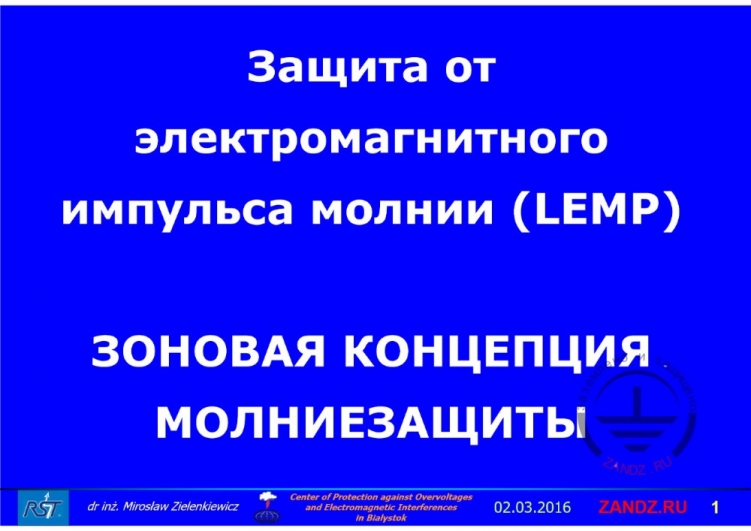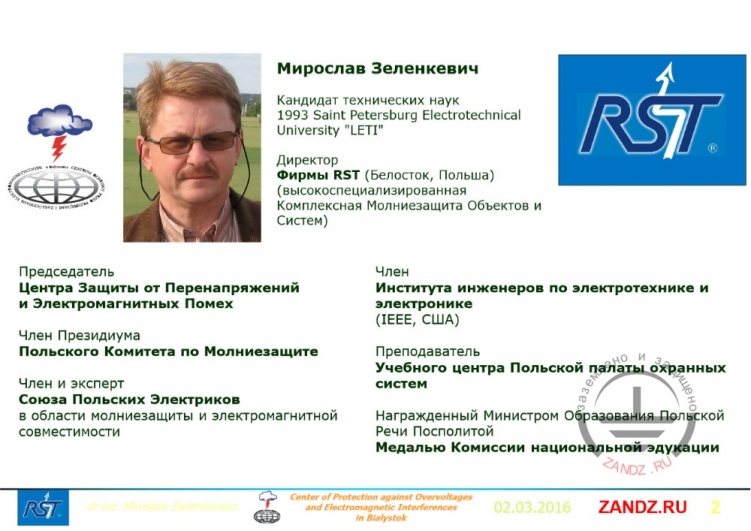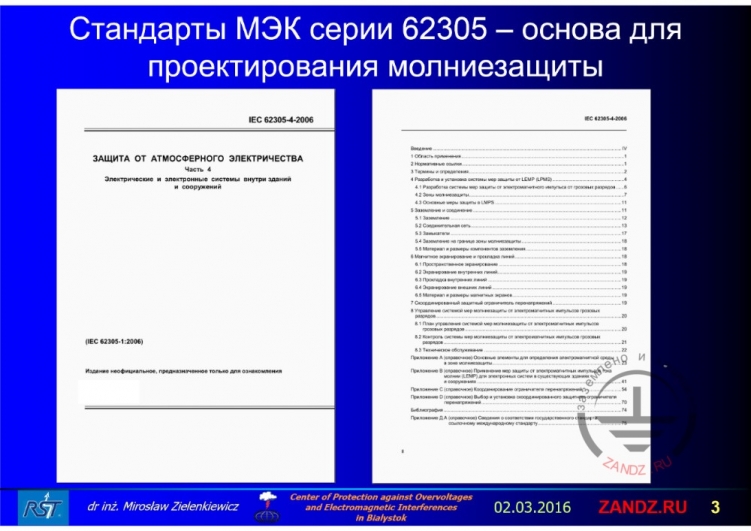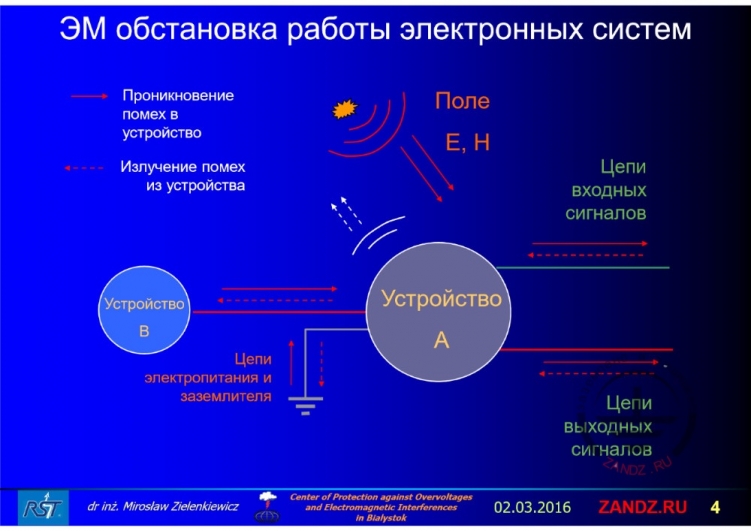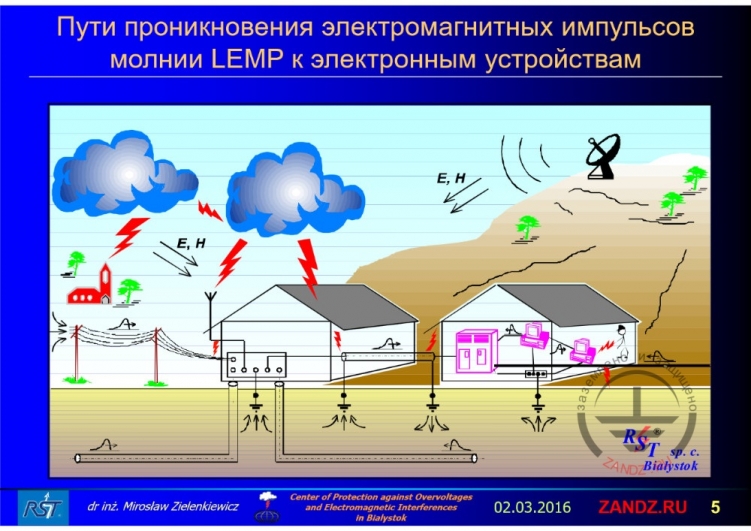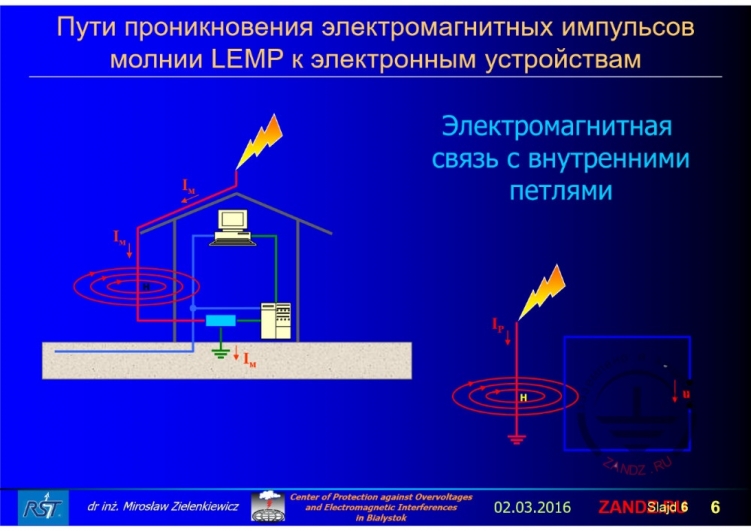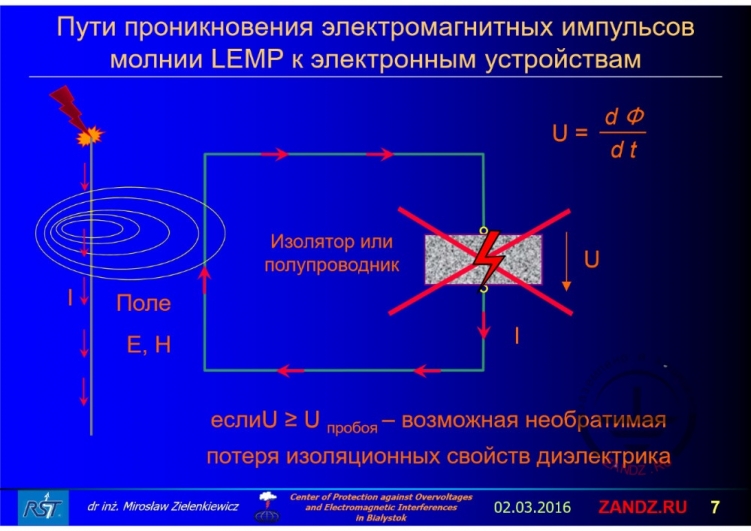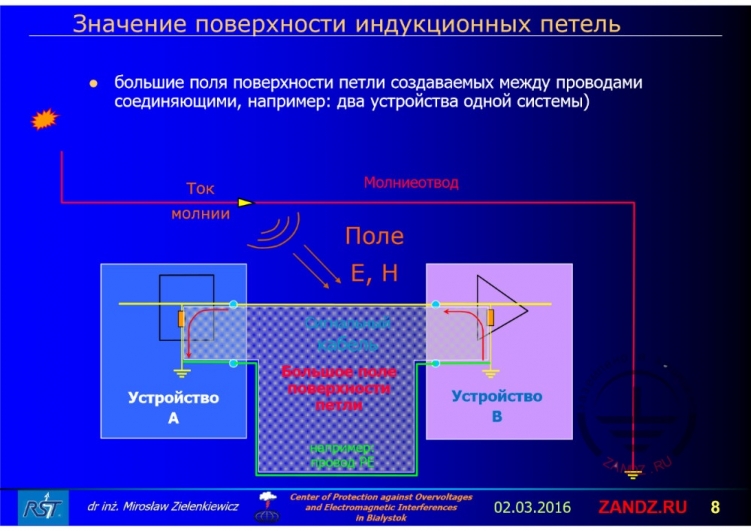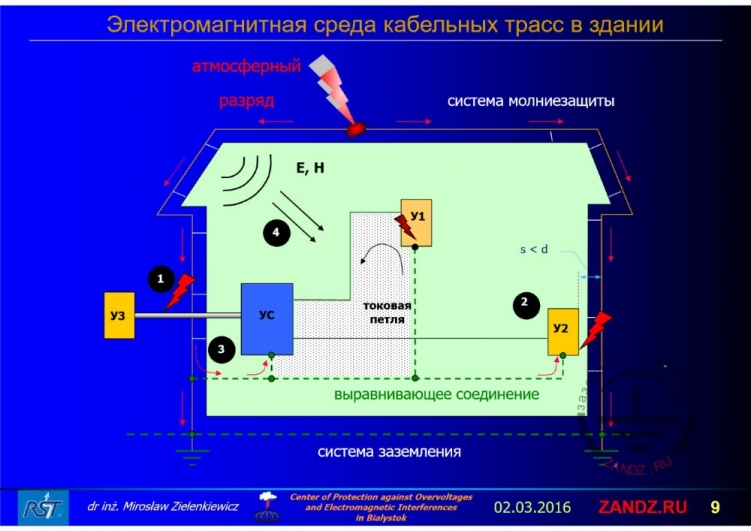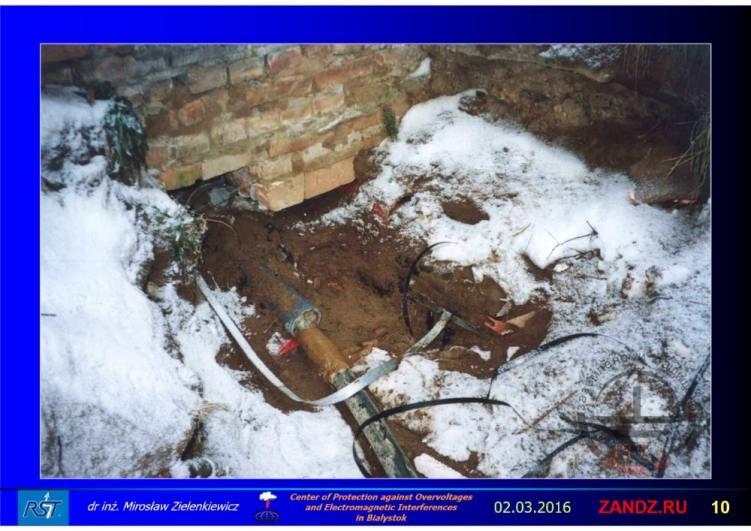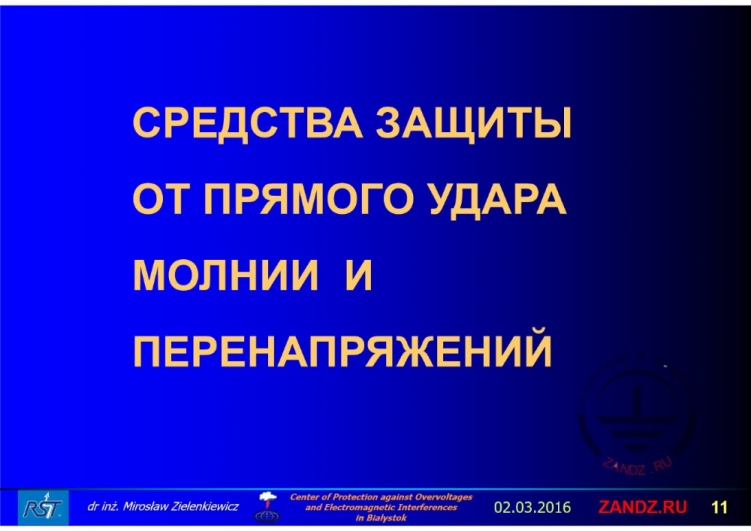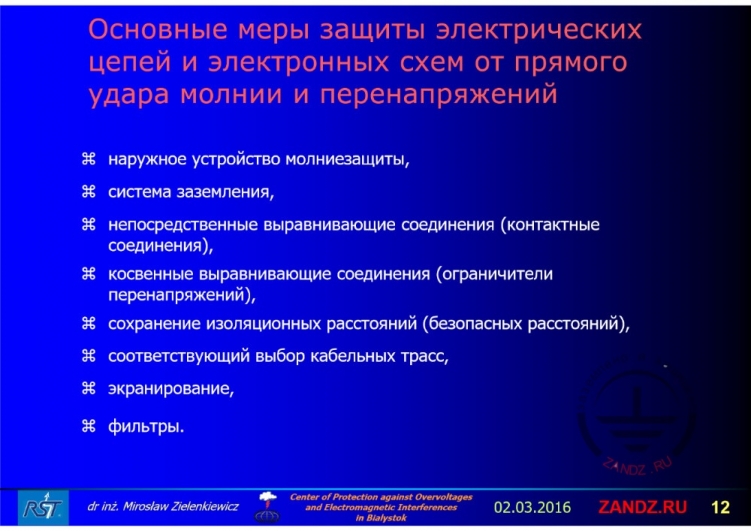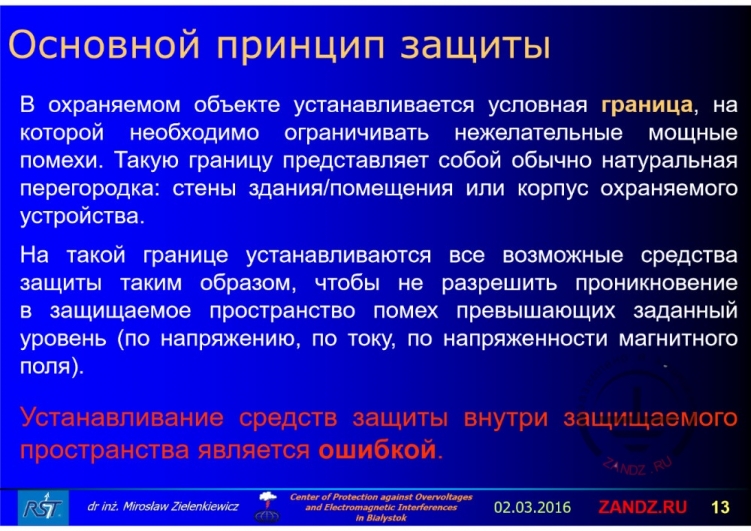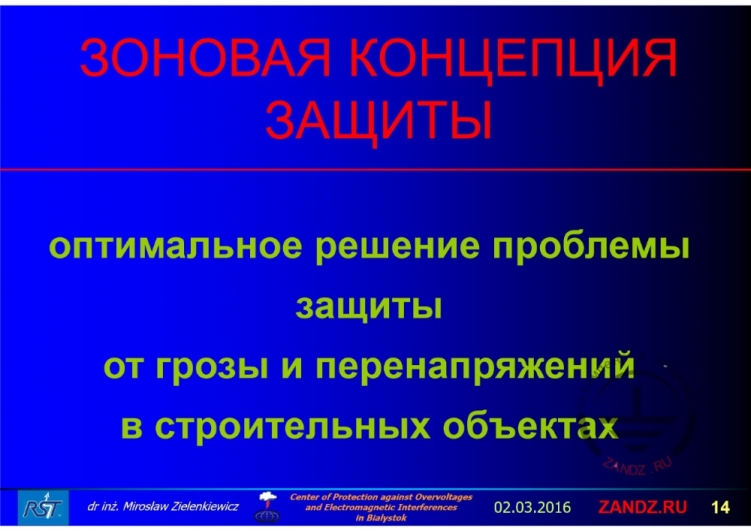|
(was held on March 02, 2016 at 11:00 Moscow time) |
|
|
Modern lightning protection system is intended not only for the protection of the protected object from a direct lightning strike, but it should also possess qualities, restricting indirect effects of lightning current onto the object:
To realize this target, new measures are now used. They are concentrating on the shielding of buildings, premises and cable tracks, and also on the protection from surges caused by lighting current used as a measure of potential equalization of working cable cores by restricting surges. The target of the webinar is to advance the mechanisms of forming the effects of lightning current influence on modern objects and also view of the method of diving the object to lightning protection zones LPZ 0A, LPZ 0B, LPZ 1, LPZ 2 etc. |
Full-screen mode with the quality of "720p" is recommended.
|
|
Webinar text. Page 1
|
||
|
|
|
Защита от электроктромагнитного импульса молнии – Lightning Electromagnet pulse protection
— Good afternoon, colleagues! We are happy to greet you at our event. Today we begin the new series of the webinars "Surge protection", on which we will discuss the regulatory framework and will study the application of surge protection devices, namely SPDs in various systems. 6 webinars are planned within this series. You can sign up for all these webinars at the link which I will send after I finish my speech. Our today's webinar is the first one, introductory. Its tops is "Zonal lightning protection concept" and we will study the mechanisms of formation of effect of lightning current impact on modern objects and also the methods of dividing objects into lightning protection zones. My name is Alexey Korytko, I am an administrator of this webinar and I will respond your questions and comments, so you can leave them in the chat. The chat is in the left bottom. You can ask your questions in the comments in the "general" tab below. In the end of the webinar, we will answer these questions and comments. Our meeting will last about 60 minutes. The rest of the time we will spend on questions. That's it about organization and probably the only thing which is left to do is to present our lecturer, who will be with us during the whole series of webinars - "Surge protection". About Miroslav Zelenkevich
- Mr. Zelenkevich is an acknowledge expert in lightning protection, author and co-author of more than 50 publications and more than 100 expertises, initiator and professor of the course "Bases of surge protection of electronic devices", in which more than 2000 people from different countries of Europe took part, PhD in the sphere of surge protection. These are far not all titles and merits, believe me, there are much more of them, but my introduction speech has come to an end and I am pleased to give the floor to the lecturer. Miroslav, good afternoon! Can we start? - Good afternoon! Hello, dear colleagues. Yes, we can start. I hope that everybody hears me. I am in the mountains now, that's why you can hear me well. Thank you for the introduction. I will add a bit, that I've been working in this sphere for more than 20 years. Before that, I worked as a professor at an institute, so I have a theoretical and practical experience in this sphere and I'd love to share it with you. Colleagues from Russia started to collaborate with us last year. We had an idea to approximate already accepted different measures, means to use surge protection devices, make such a series of reports. I hope it will be interesting for you, though from time to time these knowledge will be sad, because there appears some scheme-technics. But today it will be more or less interesting, because I will talk about why we protect ourselves from surges. The report will be quite short, because we don't want to steal a lot of work time from you, and if we look at the base of all my reports and talks - it is nothing more but a standard. IEC standards series 62305 EIC standards of series 62305 – base of design of lightning protection - What I am going to talk about today can be found within the standards. But, these are the standards of IEC series 62305, as you see. If you look at the first slide there, you can see these standards are in Russian already. I simply took from the Internet. We've been using them for a long time, series 62305 appeared about 10 years ago, it consists of 4 parts. And today I will talk about the things described in the fourth part. Electromagnetic situation of electronic systems operation
- Today we will talk about lightning protection and about electromagnetic situation? I think, it should be clear to everybody, but to see it one more time, I will give an example on this slide. Device A, device B, which are interconnected by some conductive wire. As a rule, it is a twisted-pair wire. Today, we are not going to talk about optical fiber splice, but about galvanic connection, conductive connection. It's clear that if we create such a connection, there appears a way for disturbances of device A into device B, and vice versa - into device B from device A. We need to remember that during protection the electronic devices are powered by the power circuit. What does this mean in practical terms? It means, that during lightning, everything that reflects in a very long network outside our device, may in some part switch to out electronics boards. We have to know that all electronic devices are grounded as a rule. First of all, in order to protect human life from electric shock. And it is also a galvanic connection with grounding. And there appears another way of penetration of various disturbances and surges. If we look at a modern electronic circuit, for example at an instrumental system. Penetration ways of electromagnetic pulses
At the penetration of electromagnetic pulses of lightning to electronic devices - Let's talk about the main problem connected with lightning protection. Here we see two buildings on the slide. I put some electronic devices into them. I ran the cables, so we could understand that disturbances get into the object via them. And let's study two cases for starters. The first of them is that an object doesn't have lightning protection system. If to look well, count according to IEC standards, such a situation is almost impossible today. Even a small object requires such a system, but let's see what will happen when a designer counted that the probability of a lightning breakthrough into this object is minor and such an object doesn't have a lightning protection system. Everybody knows that lightning is a statistical phenomenon. And it happens that a lightning gets into such an unprotected object. What happens then? Not necessarily an effect everybody knows - fire, interruption, explosion of construction materials: bricks, wood, concrete. And in this case, when lighting gets into an unprotected object, we have no control over the ways of lightning current penetration into the object. And if the router defined on the base of calculations from the second part of standard 62305, this calculation is quite complex, but not precise. And he precised, that this object requires such a system, but according to IEC we determine four categories of lightning protection. The first one is the highest, the most effective and the fourth is less effective. Lightning protection mesh on the roof refers to category 1, its sizes are 5*5 meters. Lightning rods are located every 10 meters along the object walls, but if our designer counted everything well, everything was well done by the installer and the lightning gets into the object, then it becomes clear, that it is necessary to install lightning protection system which would capture lightning current and send this energy into the ground electrode system. Yes, it happens this way. The higher is the category, so for the first category the probability of a lightning current hogging achieves 100%. It really happens this way. From my practical experience I can say that all the lightning protection systems our company implemented, which include surge protection work this way, and there are no damages. Believe it or not, but I think in the end of our talk, we will see why it happens so. But if lightning gets into our object, the current flows along the conductors of external lightning protection systems. It means that this lightning creates electromagnetic field near out electronic systems, which are inside the object. We need to understand that the direct current is not the only destructing thing, but its magnet effects have a great value today. Let's imagine that this lightning current always flows to the ground and is dispersed there, deionizes in the grounding system. It is necessary to consider, that any ground electrode is characterized by grounding resistance. It won't add resistance in fact, but let's think this is just resistance for simplicity. Everybody knows that there appears voltage drop on any resistance where the current flows. If to consider, that according to the standard, the lightning current may achieve 200 kA for the first category of protection. So taking the current is equal to 100 kA and our resistance has the value of 1 Ohm, we will easily count that on such a resistance there appears a voltage of 100 kV. And what will happen if it is real and will achieve about 10 Ohm? It is easy to count, that there appears 1 MV for all this resistance. Why is it so important? Because for the protection of human life, as we've just said, electric shock may come from all metal conductive parts inside the object, it happens because of the special system, I am sorry, I've noticed in your EIC a phrase "equipotential adequation", I am used to calling it "equipotential bonding", so there appears a new system which is a bit strange to me. There appears the system of "equipotential bonding" so we need to unite al the conductive parts in order for a human not to get electric shock. And we connect this system by the ground electrode system. So inside the object we do not ground anything, we simply equalize the potentials of all available metal buckles. If we have a connection of this system inside the object with the grounding conductor, it means that high potentials will be shifted to the object instantly when lightning will flow through the ground electrode. It also means, that such a potential will appear on the bodies of your devices and equipment cabinets. All body frames should be united and grounded by the ground conductor in order to protect them from electric current damage. Then even at the highest level of your object, the voltage value will be so high and it will remain there until there is a breakthrough in the insulation. This puncture voltage value will be the voltage value which will appear on the object. Today's electronics won't stand such potentials, won't stand such voltages that is why surge protection system is required. Electromagnetic connection with interior loops
- Where do these secondary effects come from? Here you see such a simple picture, with some computer system, server and computer standing on the territory of the object. They are interconnected by a signal cable at least, which is indicated here in blue, but the body frames of these devices are interconnected by the balancing conductor. As a rule it is yellow-green, it is included into the power supply cable, as a rule, or it is a special conductor or a mesh of balancing conductors, which is located under the server room, for instance. We see that if lightning current flows not far from our system behind the object wall, it can't flow anywhere closer, then electromagnetic field is formed here in the loop, which will appear in our system. Puncture of this loop and computer and server. What this puncture is? It is either a distance between the body frame of the device and the server plate or some semi-conductor which will be located on the way of our loop. It is hard to count the number of loops in the object. It is necessary to struggle with them, but we need to understand why. We see that in such a loop, if we present it by the value of the puncture voltage, if we exceed such voltage, puncture will happen. Loss of dielectric insulation features
- How this puncture finishes? Regardless of what we have in this breakthrough. If it is an insulator, it may burn and nothing will happen, but if it is a semiconductor, it will depend on luck, if the small voltage activates in a correct direction, then the semiconductor will switch on and activate. But mainly these energies are much greater than the resistance of our devices and this semiconductor or insulator will simply burn, which will deactivate our systems. On the top right, we see a formula which shows the information we know, the greater electromagnetic flow is captured by the loop, and the greater is the voltage value. It means that reduction of this loop surface is one protection measure. How to do it? The designer should lay the cables the way, there would be no possibility to create such large surfaces. Value of induction loops surface
- In the result, in device A there can be a burning of electronic elements and the same in device B. The size of the loop on the image you see is an example of a protective wire. The field value is great between the signal and the protective wire. Electromagnetic environment of cable routs in the building
- Let's look at the moment of a lightning strike from the point of view of all effects which we need to consider when we arrange protection. And this example should show, why today's lightning protection system is not only exterior conductors, lightning rods, lightning arrestors and grounding systems and also new components well -known to everybody, the so-called surge protection methods. In fact, if there is a current, it flows to the ground, as we said before; let's see at the grounding point on the left. And let it be the only one for the first approximation, then the potential from this point will move to the body frames of all conductors, when lightning current flows through the ground electrode. It is an obvious case. Number 1 indicates the place where a jump off of the lightning current to the external cables or external body frames of the devices is possible if they are incorrectly installed without necessary insulation distance from lightning protection elements and ground electrode system. For example, it happens always when an object possesses lightning protection system and we introduce cables either feeding or low-current, but it is impossible not to cross it with the cable or not to meet the ground electrode in some point. Question - on what distance it achieves safe values. Cases of input cables into the object in practice in order to avoid such effects when lightning can jump and spoil cable insulation; we simply put them into plastic pipes. In our old standard there was such a solution method, that in this case this pipe should be at least 5 mm thick. Question - why 5 mm - was not discussed, but if to consider, that the strength of polyethylene is from 10 to 20 kV per mm, and 5 mm gives is from 50 to 100 kV in the result, and the value for AC is 50 Hz. For these currents it will be much greater. So this way we can fight with these approximations to the new lightning protection systems. The second case, which we see on the right, is simply nonobservance of safe distance of the systems inside the object. Above you see the formula s Example of cable entry into the object
- On the picture you see an example of cable input into the object. It's a joke, but we tried our best, you know the rest. But you see there is a pipe, right? But it is not long, if we lay this pipe further at the distance of at least 6 meters from the object -it's a standard in my company. It means, the probability of a jump-off of the lightning reduces strongly, but the question of running this grounding inside the object is interesting. Is it necessary in this specific place or in some other? But today we can't discuss all questions. Lightning protection means Direct lightning strike and surge protection means
- What comes from this? What I've been talking about. Everybody understands that it is necessary to protect ourselves. Question: how to protect? As we know, the experiences of different countries are also different. We had our own standard in Poland. I know your old standards, the Soviet ones; they'd been applied not long time ago. Now if I know well, they've been updated and IEC 62305 was partially introduced, but I don't think it makes sense to introduce the part of it, because problems may arise. In every part of IEC standard there is a separate area of expertise. If we divide the completeness of this knowledge into pieces and choose what we need, we can get a completely non-understandable solution. I don't know what your standard is like today, though I have it, I had no time to study it. I recommend seeing how it is done in Europe now, because the standard is unique for all countries of the European union, there are no other. There appears some information about ESE lightning protection systems, but coming from my knowledge I don't think it is a reasonable approach. I know there are other measures on this issue. I can't understand how ESE lightning protection systems function that is why I work with the conventional lightning protection, which is composed of conductors laid on the external walls of the buildings and roofs. Main lightning protection measures
It is necessarily an exterior lightning protection device, lightning rod mesh or, sorry, mesh of horizontal or vertical lightning rods on the roof, lightning rods on the walls of the building, grounding system, which accepts this energy and disperses it in the ground. Grounding system is always one, of one object, nobody makes designated grounding systems today, because if we divide two grounding systems within one object territory. It is clear that lightning will check our division and will jump to another system from one system to another - we will be deep in trouble. And finally - balancing connection, contact connections - it is what I've been talking about. Inside the object there is a special system, it is first of all based on the yellow-green conductor of power supply cable, but additional balancing tapes on the walls of technical premises are laid, they reduce the length of these connections and reduce their inductivity. Another method - I named it, don't know correctly or incorrectly in Russian - "Indirect balancing connection", that is these connections are not direct, but surge protectors are meant here. Why "indirect balancing connections"? Because in the places in which we can't unite two conductive parts directly. And it is the case when one part has a different potential, for example, phase power supply cable or simply a thermal core of the signal conductor. We can’t connect it directly with another conductor, which as you know, is grounded. If this is a wire of equipotential bonding system, then we simply use the surge arrestor. I will tell a bit more when I finish this slide. There is another example there. The method is as follows - keeping of insulation distances, safe distances, and this value is counted by the formula from the standard. A corresponding choice of cable tracks in order to reduce the size of cable loops. Shielding as the main method, the initial method of electromagnetic effects protection. I can only tell how it happens in Poland, but I think your specialists also face shielding when we deal with a shielded cable. We all know there are shielded cables. Mainly everybody deals with the shields of low-current cables. It's a rare thing that somebody would use a shielded cable of power supply. And if we remember why this cable is a source of electromagnetic pickup, because large currents flow in it and today all these currents are changing quickly, it means that shielding of the cable has a great sense. In the fourth part of the standard IEC 62305 you will find a lot of information about shielding, because today to protect our homes from lightning currents, we make shields of premises and whole buildings. The lightning protection system itself is a good shield, if it is quite dense, and the mesh is thick. Also reinforced concrete structure of objects is also used as a shield. Filters to cut the part of unnecessary signal which tries to get into our system. Let's come back to the question of indirect balancing connection. Let's study some example where an external cable enters our object. Let's agree that there is a million of cores in this cable. It makes sense. What do we do with such a cable so unnecessary pulses would not penetrate through its cores into the object? It is clear, that all free cable cores, which are all free cable cores should be grounded at the entrance into the object. For that, we will lay a conducting bus under this cable, which we connect with the ground electrode by the ground conductor. It means, that in this case, if we terminate all breaking cores to this bus, they will have the same potential and secondly what flows through them into the object, will be terminated to the ground. It is good. But we can't terminate directly all the cores of phase and single conductors, because there will be a short circuit and the signal or current won't go to the load. In this case, in order to balance the potential of these cores we use the elements called surge arresters. This element presents itself an active substance between the electrodes. One of electrodes is directly connected to this bus and the second electrode is connected to the protected bus. At the moment, when the dangerous voltage appears between the electrodes, it will be limited because this active substance will shift from high-ohm to a very low-ohm state. And it switches quicker than the lightning pulse grows, quicker than 10 ms, can be about dozens of nanoseconds and clamping voltage comes to our protected devices, which is safe for them. Main protection principle
- In the standard you will notice the main protection principle, about which we will be talking today, we come to the topic which is the main one, when there is a conventional border in the protected object, on which it is necessary to limit undesired false disturbances. Such a border presents itself a natural diving wall, building wall or a body frame of the protected device. All possible protection means are put on such a border in order not to allow penetration of disturbances exceeding the fixed level into the protected space (voltage, current, magnet field intensity). Installation of protection means inside the protected object is a rough mistake. There are protection means installed at the border. For example, there is a case when a cable crosses the wall of the object and we put surge protection inside. It means, that the overvoltage energy will first penetrate into the object, will terminate via surge protection elements on the conductor protecting lateral power supply, which is grounded, so the overvoltage current will flow and there will be created a loop inside the object, which will radiate its unnecessary electromagnet energy. That is why, we don't need such environment, we put protection means at the entrance of the cable, not inside.
Best solution of protection problem
- The zonal lightning protection concept appears from such discussions. It is really an optimal solution of protection problems from thunderstorm and overvoltage at the construction sites. It allows designers not to search for unnecessary solutions but take something which is ready for today.
Next Page >>
|
|
Related Articles:


